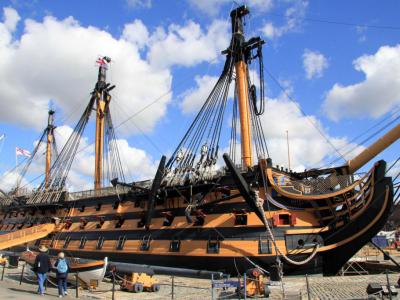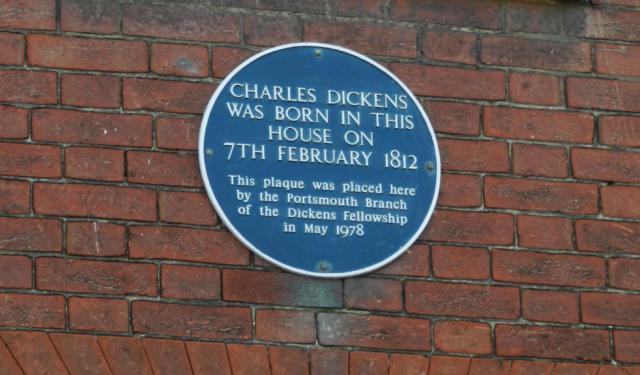HMS Victory, Portsmouth (must see)
Six ships were called HMS Victory. The first was a 42-gun vessel, demolished in 1609; the second was another 42-gunner, broken up in 1691; the third was a 100-gun first-rate, burned in 1721; the fourth was also a 100-gun first-rate, wrecked in 1744; the fifth was an 8-gun schooner in Canada and burned in 1768.
The sixth is Admiral Lord Nelson's HMS Victory, a first-rate 104-gun ship of the line. She was Nelson's flagship in the climactic Battle of Trafalgar in 1805. Nelson died on her quarterdeck while under fire from the French 74-gun Redoutable. Trafalgar was the last sea battle of Victory's career. She was relegated to 2nd rank in 1807.
HMS Victory saw service as a troopship until 1811. From 1813 to 1817, she was used as a prison. In the 19th century, Victory was periodically under threat of being broken up. By 1921 the vessel has collapsed. Shipping magnate Sir James Caird, a principal donor of the National Maritime Museum, underwrote the public Save the Victory campaign.
The Victory was moved to the No. 2 Dock at Portsmouth, the oldest dry dock still in use. No. 2 Dock became her permanent home. The restoration was interrupted by World War II. There was some damage from a 500-pound bomb during the Blitz, but the country and Victory carried on.
Preventive maintenance for the 18th-century Victory will always go on. It was decided to restore the ship to her Battle of Trafalgar condition in 1920, but this was not achieved until 2005, just in time for Trafalgar 200 celebrations.
HMS Victory is part of the National Historic Fleet and is also the flagship of the First Sea Lord since 2012. She is the oldest commissioned ship in the world. As a museum ship, she attracts more than 350,000 visitors annually.
Visitors can descend to the bottom of the dry dock. A view from the bottom of a 3,600-ton warship is a first. The Victory gallery is refitted. The film, interactive exhibits, and battle artifacts tell the ship's story. And there is the 200-year-old ten-foot-tall figurehead.
The sixth is Admiral Lord Nelson's HMS Victory, a first-rate 104-gun ship of the line. She was Nelson's flagship in the climactic Battle of Trafalgar in 1805. Nelson died on her quarterdeck while under fire from the French 74-gun Redoutable. Trafalgar was the last sea battle of Victory's career. She was relegated to 2nd rank in 1807.
HMS Victory saw service as a troopship until 1811. From 1813 to 1817, she was used as a prison. In the 19th century, Victory was periodically under threat of being broken up. By 1921 the vessel has collapsed. Shipping magnate Sir James Caird, a principal donor of the National Maritime Museum, underwrote the public Save the Victory campaign.
The Victory was moved to the No. 2 Dock at Portsmouth, the oldest dry dock still in use. No. 2 Dock became her permanent home. The restoration was interrupted by World War II. There was some damage from a 500-pound bomb during the Blitz, but the country and Victory carried on.
Preventive maintenance for the 18th-century Victory will always go on. It was decided to restore the ship to her Battle of Trafalgar condition in 1920, but this was not achieved until 2005, just in time for Trafalgar 200 celebrations.
HMS Victory is part of the National Historic Fleet and is also the flagship of the First Sea Lord since 2012. She is the oldest commissioned ship in the world. As a museum ship, she attracts more than 350,000 visitors annually.
Visitors can descend to the bottom of the dry dock. A view from the bottom of a 3,600-ton warship is a first. The Victory gallery is refitted. The film, interactive exhibits, and battle artifacts tell the ship's story. And there is the 200-year-old ten-foot-tall figurehead.
Want to visit this sight? Check out these Self-Guided Walking Tours in Portsmouth. Alternatively, you can download the mobile app "GPSmyCity: Walks in 1K+ Cities" from Apple App Store or Google Play Store. The app turns your mobile device to a personal tour guide and it works offline, so no data plan is needed when traveling abroad.
HMS Victory on Map
Sight Name: HMS Victory
Sight Location: Portsmouth, England (See walking tours in Portsmouth)
Sight Type: Attraction/Landmark
Guide(s) Containing This Sight:
Sight Location: Portsmouth, England (See walking tours in Portsmouth)
Sight Type: Attraction/Landmark
Guide(s) Containing This Sight:
Walking Tours in Portsmouth, England
Create Your Own Walk in Portsmouth
Creating your own self-guided walk in Portsmouth is easy and fun. Choose the city attractions that you want to see and a walk route map will be created just for you. You can even set your hotel as the start point of the walk.
Famous English Writers Walking Tour
Jane Austen was born in 1775 in Steventon, North Hampshire. In her day, Portsmouth was a rough-edged seaport filled with people she considered "underbred." Nevertheless, she often traveled to Portsmouth to visit her brothers Francis and Charles, stationed there with the Royal Navy. Austen included Royal Naval characters in her novels, Persuasion and Mansfield Park.
Charles Dickens was... view more
Tour Duration: 2 Hour(s)
Travel Distance: 3.7 Km or 2.3 Miles
Charles Dickens was... view more
Tour Duration: 2 Hour(s)
Travel Distance: 3.7 Km or 2.3 Miles
Historical Dockyard Tour
The naval theme has always been dominant for Portsmouth. Most of the city's historic events are in one way or another associated with its seaside location. Portsmouth's Historical Dockyard is the area that offers a glimpse into the city's maritime past.
The very first notable landmark here is Victory Gate, the dockyard's main entrance. Inside, visitors will find HMS... view more
Tour Duration: 1 Hour(s)
Travel Distance: 0.4 Km or 0.2 Miles
The very first notable landmark here is Victory Gate, the dockyard's main entrance. Inside, visitors will find HMS... view more
Tour Duration: 1 Hour(s)
Travel Distance: 0.4 Km or 0.2 Miles
Portsmouth Introduction Walking Tour
The Anglo-Saxon Chronicle claims a warrior named Port and his two sons killed a noble Briton in Portsmouth in 501 AD. Winston Churchill, in his "A History of the English-Speaking Peoples," wrote that Port was a pirate who founded Portsmouth in the same year.
King AEthelwulf sent a force to drive off Viking raiders in Portsmouth in the 9th century. The Danes loved Portsmouth, but they... view more
Tour Duration: 2 Hour(s)
Travel Distance: 4.2 Km or 2.6 Miles
King AEthelwulf sent a force to drive off Viking raiders in Portsmouth in the 9th century. The Danes loved Portsmouth, but they... view more
Tour Duration: 2 Hour(s)
Travel Distance: 4.2 Km or 2.6 Miles






